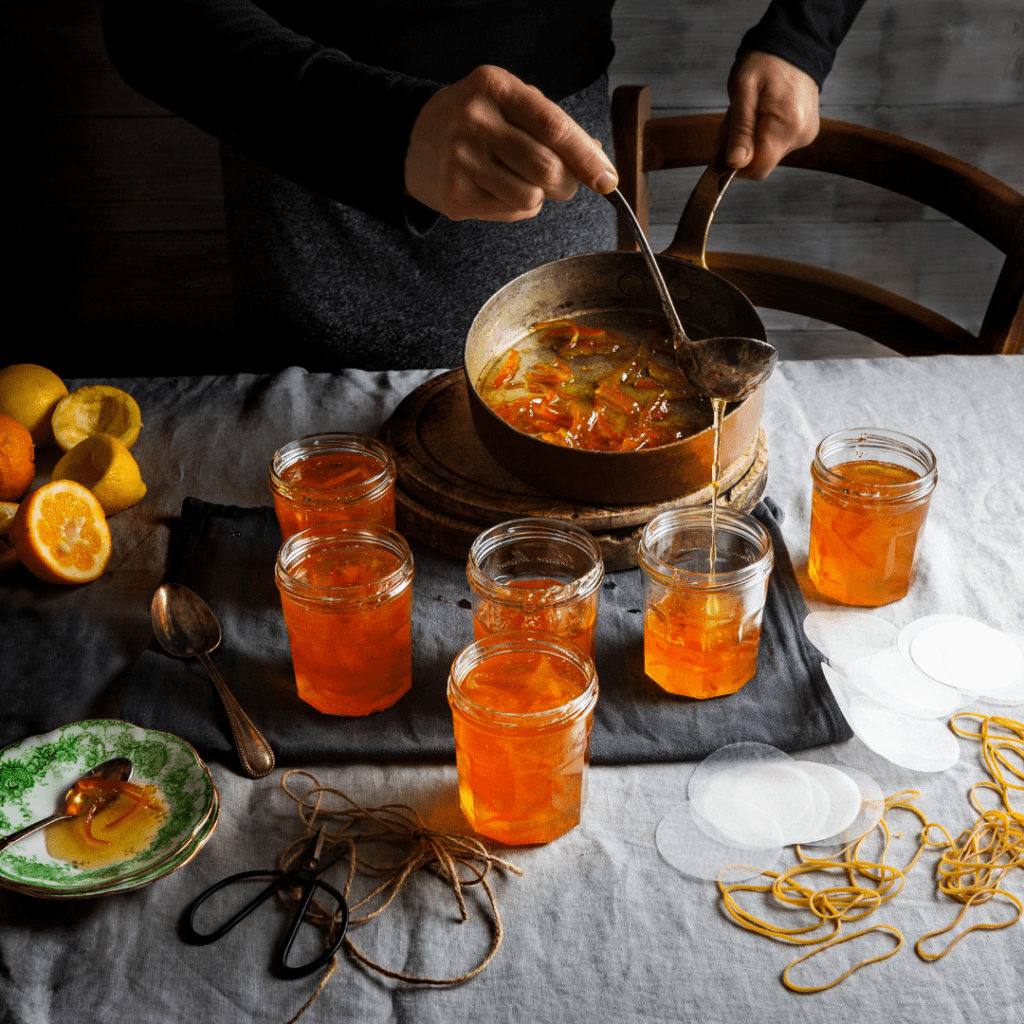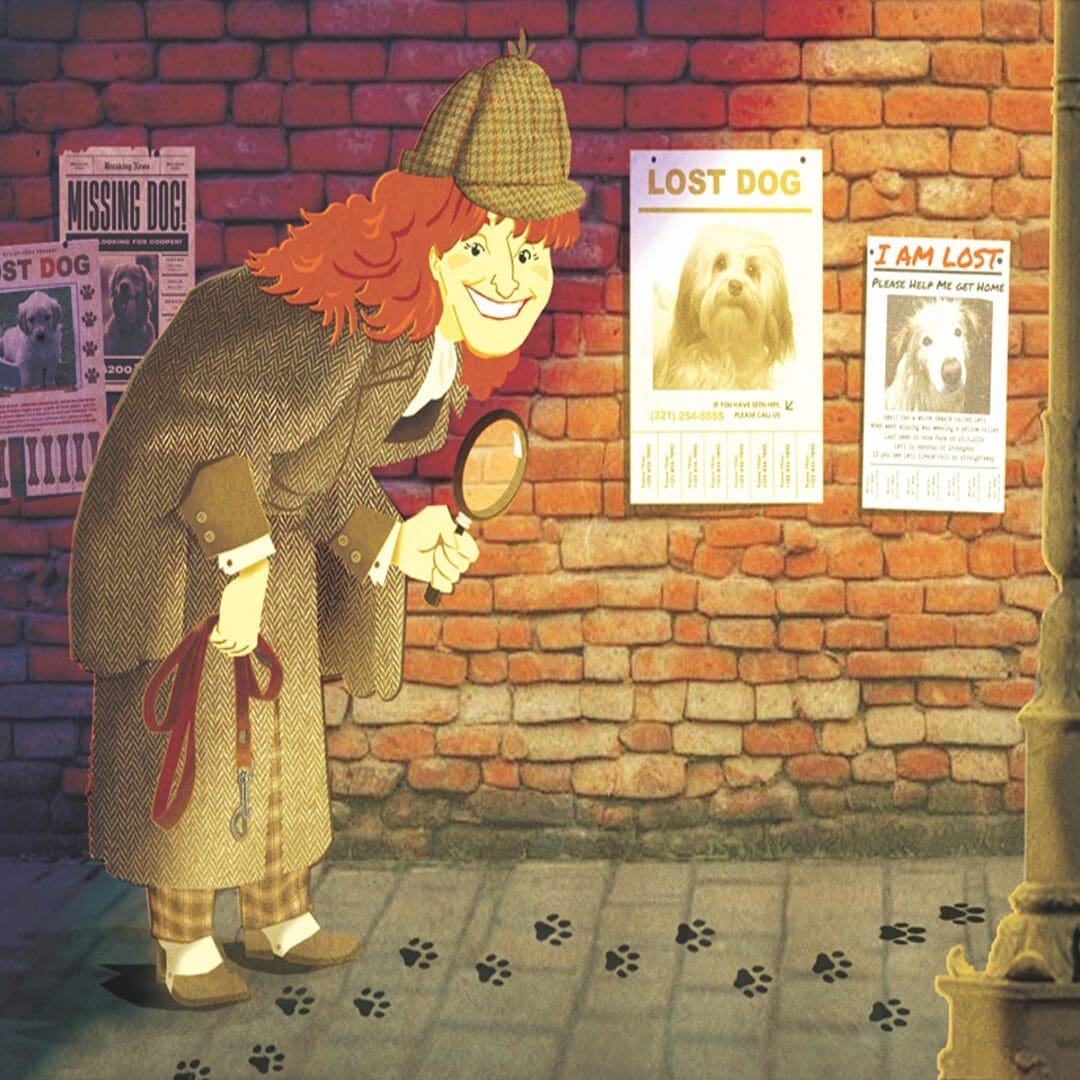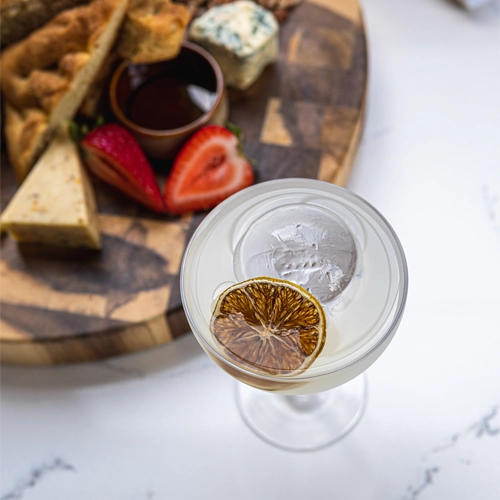by Diane Roberts | December 16, 2024
The Art and Alchemy of Making Jelly
Diane Roberts shares childhood memories, the secret to preserving and her family's recipe for dewberry jelly.

My mother had many skills. She could change a tire, throw a lump of clay on a wheel and turn it into a bowl, rewire a lamp and behead any cottonmouth dumb enough to slither across her path. She kept a machete in her van for just such eventualities, which, in North Florida, are fairly common. Mama could also preserve, pickle or render into jam just about anything that could, however loosely, be defined as “food.” Not solely the standard cucumbers, strawberries, blueberries and squash, but rose petals, basil leaves, bourbon, bacon and stinging nettles. She made more kinds than I could keep up with, stacking them on a special shelf in the kitchen. When the morning sun hit just right, the jars threw off reds, purples, golds and greens like a stained glass window.
While making jelly, my mother’s kitchen looked like the mad scientist’s lab in an old movie: boiling cauldrons, Pyrex beakers and a sinister-looking antique potato masher used to crush leaves and flowers. She liked to experiment. One year it was kudzu jelly. The reactions were decidedly mixed: Some people couldn’t get over the very idea of those choking, crawling vines producing anything edible, while others pronounced it sublime, especially when spread on a water cracker with brie.
These days, weird jams and jellies have become fashionable, showing up on the menus of nouvelle Southern restaurants that make down-home feel uptown. Mama, however, was not trying to make a point. For her, preserving was practical—except when it was sheer aggression. A friend of ours who loved absurdly spicy food informed my mother the habanero pepper jelly she’d made for him was good, but not, he said, “hot enough to make me cry.” She took that as a challenge and set to work on a recipe with more than double the recommended amount of habanero peppers and some Carolina Reaper chili flakes thrown in. It was the color of a Sarasota sunset: damn near DayGlo orange. Mama cooked it wearing her old chemistry class goggles and an N95 mask. The fumes were so fierce they’d clear a dragon’s sinuses. She presented the concoction to the friend, who confessed that he didn’t quite weep, but his eyes did indeed water. A lot. Mama reckoned she won.
Despite what Big Pectin wants you to believe, making jams and jellies is not easy. My first attempt at blueberry jam was a disaster.
—Diane Roberts
When I was little, I’d sit and eat pound cake while watching her and my grandmother grind bell peppers, chop sand pears or strain elderberry juice through three layers of cheesecloth. They stirred with long wooden spoons as they silently counted, heads bobbing a little. Most jellies and jams require 60 seconds of boiling, but there are those that need two minutes. They never used a watch or a timer, only the clockwise sweep of the spoon. There was something magical about the transformation: solids become liquid, then solid again. After the mix was ladled into sterilized Mason jars to cool, I’d listen for the sound of the lids popping as they sealed the jars tight. I knew that sweet ruby solution would, through some sort of kitchen alchemy, become strawberry jelly.
One morning when I was visiting home, I found her dumping a bag of sugar into a large simmering pot of pureed Vidalia onions, vinegar, celery seeds, mustard seeds and turmeric. My mother said, “People don’t know how to do things. You don’t know how to do things.” It was true. I could not change a tire or rewire a lamp. If pressed, I might manage killing a snake, though I’d prefer to avoid any situation that might render that necessary. I became ashamed of my stereotypical egghead uselessness. By God, I could learn to jam. And jelly. And preserve. I could learn my mother’s occult secrets. “OK,” I said. “Give me a lesson.”
Despite what Big Pectin wants you to believe, making jams and jellies is not easy. My first attempt at blueberry jam was a disaster. It would not set. When that happens, you have to cure it by dumping the syrupy non-jam back into a pan, adding more sugar and Sure-Jell. It usually works, but not always. Mama figured I should go for something easier: fig preserves. “The cat can make fig preserves,” she said. Step one: Go out back to the fig tree, and pick about 5 pounds of ripe (but not mushy) Brown Turkey figs. Make sure you’ve applied Off! Deep Woods insect repellent to every inch of your body to slow down the plate-sized mosquitoes determined to suck your blood. Step two: Wash and de-stem the figs, put them in the largest heavy-bottomed pot you own with the juice of two lemons and five pounds of sugar. Step three: Bring the mixture to a low boil and panic. Mama had disappeared somewhere outside and failed to tell me what to do next.
Diane Roberts shared her mother’s recipe for dewberry jelly.
She finally reappeared carrying a basket of okra destined for pickling. Seeing me trying to find the index card with the recipe, she rolled her eyes and said you simply keep stirring until the figs “feel right.” If you don’t stir for long enough, they don’t turn that silky sweet mahogany brown color. If you stir for too long, they’ll cool into a mess as hard as concrete.
This was terrifying.
My mother’s recipes are inscribed on 3-by-5 index cards. In code. The one for mayhaw jelly says, “Smith Crk nr Slough pick yellow bucket. Simmer 1-1.5 cups H2O. Strain. 4 cups, 6 sugar, SuJ, 1 min. Pink.” Translated, this means drive down to the family swamp in Wakulla County (seriously, we own Florida swampland) and pick berries by the slough—mayhaw trees prefer watery soil. Use the yellow bucket that holds 3 to 4 pounds of berries, which, once cooked with a cup or so of water and then strained, yields 4 cups of juice. Add a box of Sure-Jell and bring the mixture to a rolling boil for a minute. Not sure why my mother felt the need to note that mayhaw jelly is pink.
Many of her recipes give instructions on where to get the thing you mean to preserve. My favorite dates from the early 1970s and starts like this: “Dewberries—best north pasture lock up pony.” Behind our house was a field home to rabbits and small birds with a tangle of vines that grew along about 40 feet of fence, covered in white blossoms in March and fat, dark berries in April. Mama’s note reminds her to put Ricky, the ineffably hostile Welsh pony, in the barn. His hobby was biting people on the back of the neck.

In case you’ve never encountered dewberries, they’re an undomesticated cousin of the blackberry, sweeter, richer, wilder-tasting and native to North America. The most common variety in the South is rubus trivialis, and it grows damn near everywhere. Blackberries—available in stores and at farmers markets—are fine, but they are not dewberries. You have to work for dewberries. They’re a bit shy, hiding under leaves. Pull them gently off the vine, one by one, and try not to let your hands be cut to ribbons by the prickles. They don’t all ripen at once, of course, so you have to pick day after day after day. Don’t pick any that have red showing. Those are still sour. But once you get a decent-sized haul, you’re ready to make the best and most beautiful jelly—a jelly that tastes like spring sun. My mother didn’t give away her dewberry jelly. It was reserved for family, for Christmas breakfast, Easter brunch or favored house guests.
I made a successful batch of dewberry jelly in June. It was dark purple and sweet but not so much as to overcome the scent of the field and the rain in the fruit. Sometimes I just eat a spoonful of it and taste my mother’s love of creation, the care she put into food. I taste my childhood. Here’s the recipe, rendered, more or less, into standard English. Cherish it.





